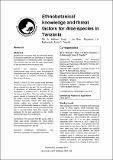| dc.description.abstract | Background: The genus Aloe has long been known
for its use in healthcare and cosmetics. In Tanzania,
overexploitation is threatening some Aloe species
with extinction and yet, little has been documented
on the abundance and biocultural uses.
Material and Methods: Semi-structured
questionnaires were used to obtain ethnobotanical
information from 236 respondents across 22 villages
in four regions of Tanzania (Kilimanjaro, Tanga,
Mara, Katavi-Rukwa).
Results: A total of 23 Aloe species were identified,
20 of which were being used locally and were mostly
being collected from the wild. We report the uses of
A. mzimbana, A. volkensii subsp. volkensii, A.
leptosiphon, A. parvidens and A. bicomitum for the
first time in East Africa. The most preferred species
were A. lateritia, A. duckeri and A. secundiflora which
are three common, widely distributed species.
Diseases frequently treated with Aloe species
include malaria and general stomachache in
humans, and Newcastle disease in chickens. Some
Aloe species were found to have gone extinct locally
due to over-harvesting. Rare Aloe species were
perceived to be less preferred as they mostly
occurred far away from settlements.
Conclusions: We conclude that the genus Aloe is
widely used across Tanzania and needs strong
conservation measures to prevent individual species
from becoming extinct in the wild. | en_US |

